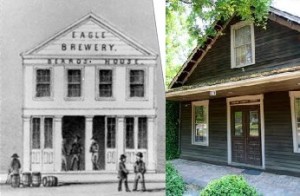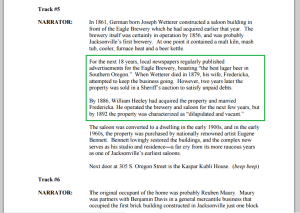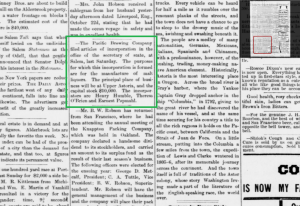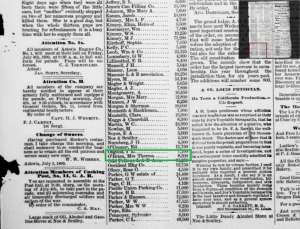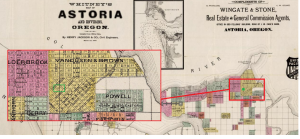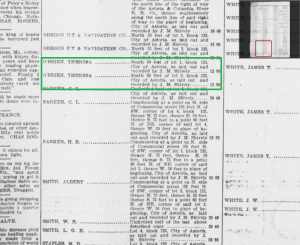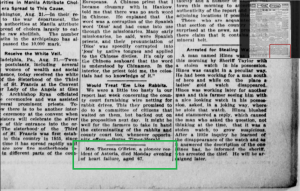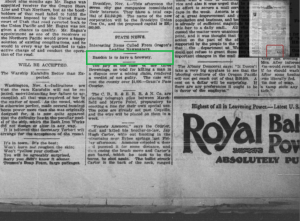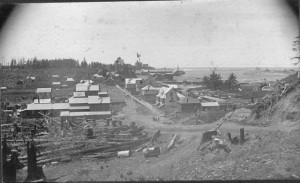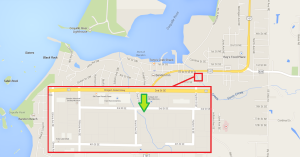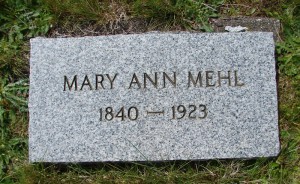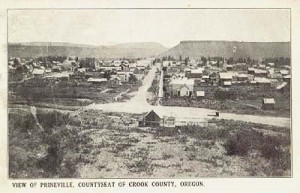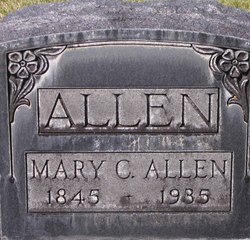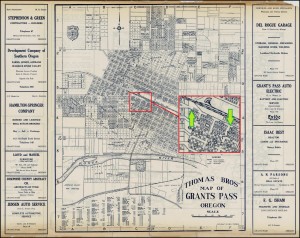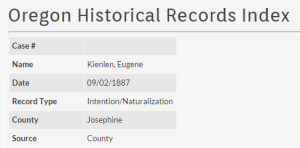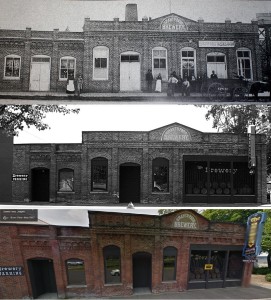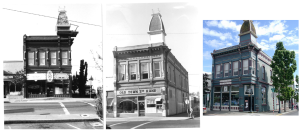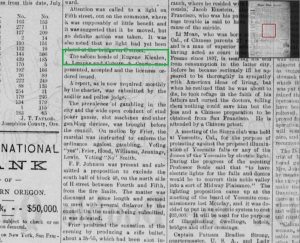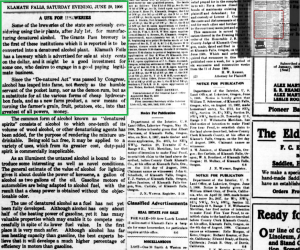Oregon’s First Women Brewers [1879-1908]
A female who brews beer. syn: brewster, brewess
Women and beer. What a tangled mess. Currently, women are less then a quarter of the craft beer work force. Macrobreweries don’t know how to advertise to women, craft breweries tend to stereotype “women beers” as light and fruity. For decades women’s bodies sold beer. And before that – what exactly? We know that in the Bronze Age ancient Sumerians worshiped the goddess Ninkasi by singing her beer recipe hymn. And we have records of Viking, Greeks, and Romans claiming beer as a woman’s beverage and a woman’s task. In fact, women were brewsters from the beginning of brewing and then well into the middle ages. After the Black Plague in the 14th century, beer moved away from a domestic art and towards an industrial practice.
In the colonies, women continued to be the avid homebrewster for friends and family. These settlers, like their forefathers, used beer as a means of potable water and substance heavy nutrients. Outside of home, women were commonly tavern-keepers, brewsters, and barmaids. Thomas Jefferson is often mentioned as a Founding Homebrewer, but his wife, Martha, did the majority of the brewing. In 1734, Mary Lisle became America’s unofficial first brewster when she took over her father’s brewhouse in Philadelphia. As beer became commercialized, women lost dominance of the trade since men had the legal, capital, social, and cultural resources to spearhead breweries. However, by the late eighteenth century brewsters and homebrewsting was on the decline, giving way to the male-dominated world of the beer industry that we have come to know.
Prohibition hit the USA in 1920 – though Oregon started theirs earlier in 1915 – and lasted 13 years before ending in 1933. Before the beer industry could re-establish itself, the second World War began. This further inhibited the budding of smaller breweries, with war policies forcing them to use adjuncts and placing tough restrictions on glass and water. Eventually Anheuser-Busch and Coors gained strong footholds – and that’s all she wrote, as they say.
A 1994 article titled “The Queens of Beer: Women Make Gains in Brewing Scene” republished from BrewingTechniques described the Queen of Beer homebrew competition, held April 16, l994 in Placerville, California. It was the first homebrew competition for women only and aimed to encourage growth of a small community into a larger one. Yet the same article also says, “In l989, there was no precedent of women brewing in micobreweries.”
Does this mean that from Mary Lisle up to 1989 there were no women brewing? With all this rich history of women and beer it seems improbable to me that only 25 years ago the US saw it’s first woman in beer. The US was founded in 1776, excluding Mary Lisle (brewing in 1734), that would mean that until 1989 there were no women brewers in the US for 213 years. There IS a precedent of women brewing in microbreweries. Yet, there no solid record of those women. California had at least thirteen recorded brewsters and Washington had at least four on record. Oregon has records of five women working in the beer industry.
It’s just not possible that a woman still living is the first Oregon brewster.
“In l989, there was no precedent of women brewing in micobreweries.”
Does this seem like good research or journalism to you?
This article is focused on detailing Oregon’s brewsters after statehood but prior to Prohibition. Utilizing various sources, I examined the state records of the breweries and any historical details I could find on women brewers. It’s time to do these ladies justice for their hard work in brewing by telling of their stories. In Oregon, these five women paved the way for us lady beer lovers before prohibition.
Fredericka Wetterer
The Eagle Brewery 1879-1880.

Jacksonville, circa 1900
The Eagle Brewery in Jacksonville, Oregon was originally opened in 1856 by JJ Holman off of Oregon Street. It went through four separate permits under different titles during its heyday.

The Eagle brewery permits 1856-1890
[UPDATE]: OBL was contacted by Lori Erickson of the Oregon Historical Society who says: “In the section about the Eagle Brewery, you have an image of the Eagle Brewery in Portland, not the one in Jacksonville (the drawing). We have the original map with that image here at the Oregon Historical Society and it included a number of drawings of early Portland buildings, including the Eagle Brewery which was originally located downtown and opened in 1873. It later moved to Southeast Portland and became the U.S. Brewery, near the current location of OMSI.” Thanks Lori for keeping the record straight!
The building still stands today on 355 S. Oregon Street Jacksonville, OR.
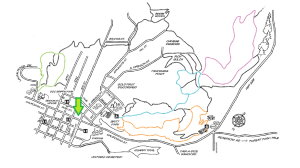
A local hiking map displays the original location for the brewery in Jacksonville
In 1859, it was sold to Joseph Wetterer, a German brewer who improved the building, the plant, and increased production. The Wetterers were huge in advertising and over 25 ads still exist on Oregon’s History Newspaper site.

Wetterer brewing crate for bottles
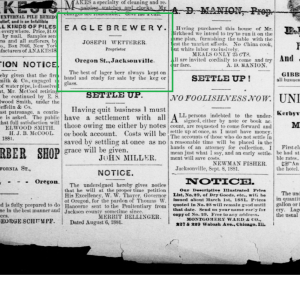
Oregon Sentinel. Jacksonville, OR. September 24th, 1881.
In 1879 Fredericka took over the brewery when her husband died. Oregon State records show that she had the permit for the brewery up until 1884, but according to a transcription from a Jacksonville history home tour from 2012, Fredericka sold the brewery in 1880 “in a Sheriff’s auction to satisfy unpaid debts” left by her late husband. In 1883 she married William Heeley, a loyal and experienced employee from the Eagle. Together they reinvigorated the brewery and operated it until its closing in 1890. She purchased real estate under her new last name in 1917. By 1900 the brewery building was converted to a household and in the 1960’s was marked as a historical site.
Theresa O’Brien
Pacific Brewing Company, 1883-87
Reports vary about the name of this northern Oregon brewery – state records indicate the title changing hands and name throughout the years. It has been referred to as Columbia Brewery, Papmahl & Block Brewery, the St. Lewis Brewery and “Hotel and Brewery.” Theresa is one of the only women that was stated specifically as a brewster . Born in 1835 outside of the United States, Theresa gained her citizenship in January of 1890, according to the Oregon Historical Records Index.
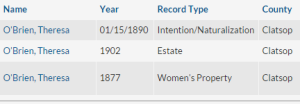
3 Oregon Historical Records Index for Theresa. Gaining Citizenship, inheriting property, and postmortem sale of estate.
In The Daily Astorian on October 23rd, 1883 Pacific Brewing Company “filed articles of incorporation… for the manufacture of malt liquors.” The little blurb goes on to explain that the brewery will be located in Upper Astoria, and the three owners were Henery Humble, Earnest Papmahl, and Theresa O’Brien.
The index displays two other records. Around 1877 Theresa inherited family land, leaving her with government described “Women’s Property.” In October 1900, The Daily Morning Astorian newspaper published Real Estate Transfers in which property bought by James Finley from the US government was resold to Theresa for $500. Thanks to Theresa paying taxes on her land in March 1901, the current location of where the house would have been is described by the lot numbers.
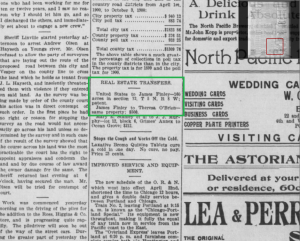
Women had restricted ownership over property. Theoretically, James purchased the land from the US in order to resell it (and it’s title) to Theresa.
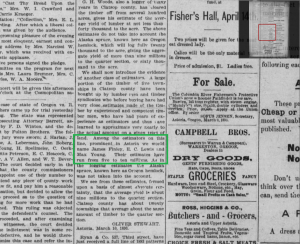
James Finley estimated timber sales. Perhaps this is how he was able to purchase so much land for Theresa. (The Daily Astorian, March 12, 1893)
Unfortunately Theresa died in August 18th, 1902 due to heart failure. The Oregon Historical Records Index makes note of the sale of her estate.
Mary A. Mehl
Bandon City Brewery, 1893-1896
Mary Ann Mehl was born in Greeneville Tennessee in 1840. She was married to German “John” Gottlieb Mehl, when they moved cross the nation to Coquille, Oregon. After very successful Coquille and Roseburg breweries, Gottlieb was opening his Bandon Brewery in 1893 when he died, leaving the brewery to his wife. The announcement was made in the Daily Morning Astorian on November 5th.
Mary ran the brewery for three years before selling it to Joseph Walser in 1896. The Bandon History Museum posted the following photo of Bandon in 1890. The #7 on the map marks the brewery. The main road was called Iris Street, which is now 3rd Street. You can see a small wooden bridge which crosses the Ferry Creek. This image not only shows the brewery, but gives the current location as well.
Mary passed away in 1923 at age 83.
Mary C. Allen
Monument City Brewing, 1900-1901
Mary Catherine Pepiot was born in Ohio in 1845 to her French parents who had crossed to the US in 1839. In early 1853 Mary and her family went west on the Oregon Trail arriving near Harrisburg in August of the same year. Mary met her husband Williamson Gatewood Allen around 1856. A decedent of Mary’s still had the proposal letter written to Mary:
“Lane Co. Oregon
November 12, 1860
Miss Catherine
I hope that you will forgive the great liberty I have taken in addressing you on a subject which for some time past has absorbed my whole thoughts. I feel that I am in love and that my future happiness in life must depend upon your smiles and your favor. Can one so good so noble as yourself ruthlessly crush my fond hopes. I pray that your reply to this if not absolutely favorable may at least enable me to in effect to win your favor. Catherine I request an answer let it be what it may but I hope to merit a favorable one
Devotedly yours
Willliamson Allen”
They married in January 1861 in Lane county. Then moved to central Oregon – Prineville – in 1869 where Williamson build the first foot bridge across the Crooked River.
They moved again in 1886 to Monument, Oregon to run a ranch of sheep and cattle. Here is the only mention of anything brewery related – “[Williamson and his son] at one time near 1900 owned a still together.” In the Heppner Gazette (Morrow County) Newspaper on December 14th 1899 the Monument Brewery is mentioned.
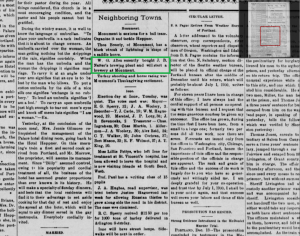
W.G. Allen purchased a brewery in Monument late 1899. No mention of his wife, who’s name is on record with Oregon State as the brewery owner.
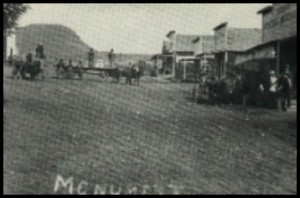
Monument, Oregon circa 1900
Williamson died in 1901. Mary Catherine was well known for her addiction to the corn cob pipe, and passed away herself in 1935 at age 90.
Marie T. Kienlen
Grants Pass Brewery, 1904-1908
The Grants Pass Brewery was first established in 1887 by William Neurath who built it near his well where Gilbert Creek (3rd Street today) crossed Front Street (G Street today).
Neurath sold the brewery’s rights in 1891 to Eugene and Marie Kienlen (both born 1859) who emigrated from Minnesota to Oregon in 1886 .
They purchased the Grants Pass Brewery land (Lot 12, Block 49) from Arthur Conklin in 1899 right before the G Street Fire.Their home was located down Front Street 2 blocks to 5th Street. In 1899 the brewery was destroyed by a fire and rebuilt by brick with an updated saloon attached.
In 1901 Eugene transferred all his property to Marie once learning about his illness which took his life in March 10, 1904. In the Rogue River Courier on July 25th, 1901 the court proceedings made note of the saloon bonds.
He is buried in Granite Hill Cemetery. Marie had to pay off $7,000 to Eugene’s children from a former marriage in order to remain in full ownership of the brewery and estates. This left Marie in charge of the brewery until the county passed Prohibition in 1908. Though not an official record, the Rogue River Courier printed a notice under “Items of Personal Interest” which referenced Marie owning the brewery for six years in June 29, 1906.
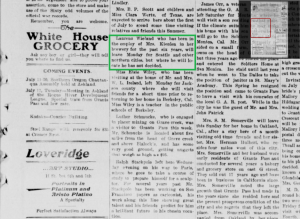
Laurenz Wieland made his leaving announcement in 1906 after six years of employment under Marie Kienlen.
After the county went dry the Klamath Fall Evening Herald reported on June 20th 1908 that she was “using [her] plants for manufacturing denatured alcohol. The Grants Pass brewery is the first of these institutions.”

Marie remarried to Eugene’s brother Samuel in 1908 after the brewery closed down. Marie died in 1934.
The same year the brewery closed down Samuel Kienlen, Eugene’s brother, married Marie in July. They lived in Grants Pass until Marie died at age 75, she is buried with her first husband.
There had been FIVE brewsters and women owned breweries between the years of 1879 and 1908 in Oregon alone. Are these ladies forgotten or ignored? Why would we ignore these pioneers? Do we forget these ladies because it was a time before Prohibition? Or because it was so early in our statehood? Or because saying “I’m the first” sounds good?
We need honor them by remembering their accomplishments. We need to remember that we are standing on the shoulders of giants. Giants that have already been forgotten, not just by our industry, but by our own gender. If there really is a sisterhood in the beer industry we need to acknowledge those who came before us – they faced greater difficulties then we could imagine.
I have linked almost all of the sources to all of these claims. However there are a few sources that I relied on the most:
“Brewed in the Pacific Northwest: A History of Beer-Making in Oregon and Washington”
University of Oregon “Historic Oregon Newspapers” database
Oregon Secretary of State “Oregon Historical Records Index”
NOTE: I am a scientist, not a historian. If you found inconsistencies or errors please contact me and let me know and I will make the appropriate edits.


